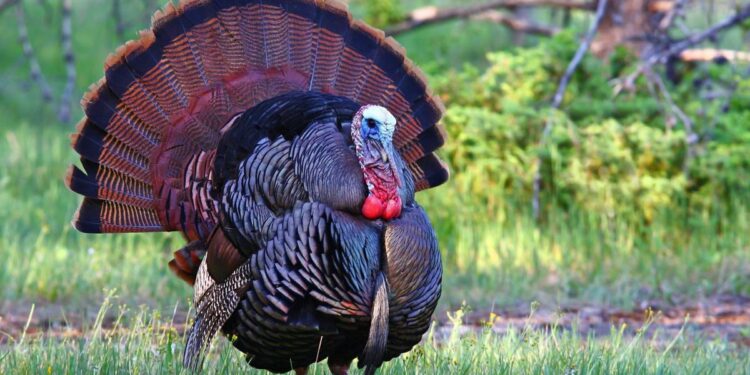Finally we have had some rain, and although we need more, that will help to kick things off for spring. And with the explosion of spring flowers and trees, comes one of the best seasons of the year, Spring Turkey Season.
The early forecasts for most of Oklahoma are very promising, and the birds are really beginning to break up into smaller groups. Most everyone who has been out this week reports great numbers of birds.
Following the change from last year, the Spring Turkey Season runs from April 16 to May 16 throughout the state. And harvest is limited to one tom turkey. A youth season is offered for hunters 17 and younger, April 8 – 9. The limit for youth season is one bird, and that does count toward the season limit.
One of the best challenges of turkey season is calling a bird to the hunter, instead of the hunter chasing the bird. With lots of practice, and some luck, a bird can be called within a few yards of a waiting hunter. If you are new to turkey hunting, then these tips from the National Wild Turkey Federation might help.
There are basically two types of turkey calls made to replicate the call of the hen, friction calls and air blown calls, although each of these might come in different versions they all have the same function, to sound like a lonely hen looking for a Tom.
Box Call — The oldest type of friction call, and one of the simplest to master is the box call. Invented in 1897 by Henry Gibson of Dardanelle, Ark., the hinged-lid box call is a simple design. Box calls are basically two pieces of wood; a coffin-shaped tone chamber and a paddle-like striker or lid. The two pieces are fastened together loosely by a screw at one end. Today’s box calls are mostly made from cedar, walnut and a host of other hard woods. Chalk or rosin is used to coat the playing surfaces to allow it to strike consistently and vibrate properly, which, in turn, produces sound.
To play or “work” a box call, lightly grasp the lid handle between the thumb, index and middle finger of the right hand while holding the box in the palm of the left. (Southpaws should reverse their hold.) Flexing the wrist, the lid is stroked across the thin, top edges of the box to produce any of several turkey calls.
Box calls are best for producing the hen or gobbler “yelp,” depending on how the box is tuned. The two-toned yelp is the foundation to communicating with wild turkeys. Box calls produce realistic clucks, another basic call turkey hunters rely on. With practice, box calls realistically reproduce a hen’s “cutting” call, which is a staccato series of clucks. Advanced callers can also produce the kee kee of a young gobbler and a rough gobble of a mature tom.
Slate-type Friction Calls — Slate calls, also known as “peg and pot” type calls, are another type of friction call and, today, come in a wide array of surface and striker materials. The earliest calls were made from a flat piece of thin wood or slate. Early strikers, or pegs, were made from hickory and other hard woods or bone. The playing surface of the earliest calls was cupped in one hand while the striker was held (like a pencil) in the opposite hand. The tip of the striker is scratched across the playing surface to produce sound.
Today’s calls come with sounding boards made of slate, glass, aluminum, ceramic and a host of other materials. Strikers come in several wood types, carbon, plastic, aluminum and more.
To properly use a slate call, grasp the pot in the left hand by forming a “C” with the index and thumb. Hold the outside edge of the pot inside the “C” and use the other fingers to give support to the bottom of the call. Hold the peg like a pencil in the right hand. Draw small circles on the sounding board to produce yelps. Pushing down firmly with the striker and pulling it in a short, straight line will create a cluck. Increase the speed of the rhythm to produce a cackle or cutting of an excited hen. Quiet purring calls, as well as louder aggravated purrs, can be mastered on the slate call. Simply allow the striker to skip across the surface as you softly draw it across the call.
Diaphragm Calls — Diaphragm calls are some of the “oldest” modern turkey calls. According to research, in 1867, Samuel McClain invented and patented a bird whistle that held a thin membrane inside a horseshoe-shaped, thin metal frame. In 1921, Henry Bridges of Maryland patented his own “sound producing device” specifically to call wild turkeys. Again, Bridges affixed a membrane material inside a horseshoe-shaped frame, which was to be held to the roof of the mouth and blown across to create a sound.
Predating these patents was the use of leaves or grass as a reed material for improvised turkey calls. The leaf was held between both hands and blown across. Early pioneers learned the craft from indigenous Americans to bring wild turkeys close for the shot.
Today’s mouth diaphragms use thin latex rubber as reed material in place of green leaves. The reed material is held inside a horseshoe-shaped frame and is most commonly taped with waterproof tape. The call is placed in your mouth with rounded side to the back and is pressed to the roof of the mouth with the tongue. Huffing breath across the reed, which causes the reed to vibrate and create sound, makes the call sound.
Because of their versatility and range, mouth diaphragms are the most widely used calls in turkey calling competitions. Realistic yelps, clucks, purrs, kee kee whistles, cackles and more can be made with some practice.
Push-Pin Calls — Also called “push-button box calls,” the push-pin call is a wooden or plastic friction box similar in shape to the paddle-type box call. Instead of having an external hinged lid, it incorporates a lid that rides on a dowel that sticks through the end of the box. A spring or rubberband is used to give the paddle proper tension as it rides over a pillar inside. Pushing the rod causes the paddle to scrape over the internal pillar, which vibrates to make turkey-like sounds.
Push-button calls are the easiest turkey call for beginners to learn to use. To use a push-button call, simply hold it in either palm and push the operating rod. Slow to medium rhythmic strokes produce yelps. Quick taps on the rod produce clucks.
Turkey Tips – for hunters new to the sport, the Oklahoma Departent of Wildlife has some great “how to” videos on their website — https://wildlifedepartment.com/hunting/resources/turkey/spring. Hunting, calling, cleaning and cooking are all included.
Want to reach a local audience and grow your business?
Our website is the perfect platform to connect with engaged readers in your local area.
Whether you're looking for banner ads, sponsored content, or custom promotions, we can tailor a package to meet your needs.
Contact us today to learn more about advertising opportunities!
CONTACT US NOW






